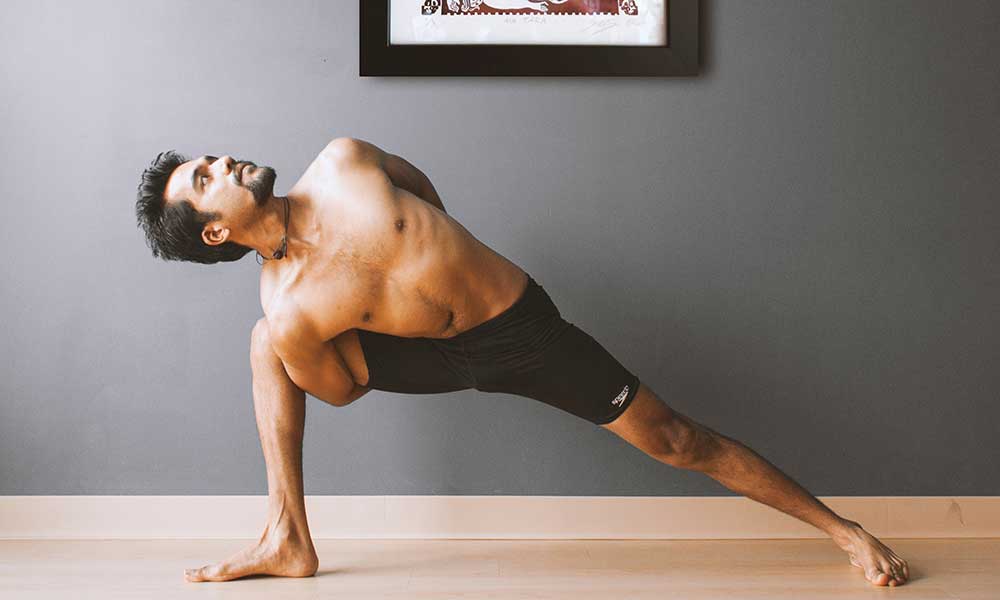If yoga is a regular part of your routine, you most likely own a yoga mat—but how often do you clean it? Yoga mats are the perfect breeding ground for hosting a plethora of different germs and bacteria. When we do yoga, especially styles like Bikram or power vinyasa, we tend to sweat a lot. When the sweat falls onto the mat, it can cause bacterial growth and smelly odors. The sweatier the practice, the ickier your yoga mat will ultimately get. To avoid having a thick layer of bacterial build-up, it’s worth it to wipe down your yoga mat after each practice. To lengthen the lifespan of your yoga mat, you should also try to give it a deep clean at least once a month.
How Dirty Is A Yoga Mat?
It’s something we probably don’t give much thought to, but the truth is, our yoga mats are pretty dirty. An article in ABC-13 News describes how one scientist examined samples taken from a personal mat as well as one from a yoga studio. The mats from the yoga studio were much cleaner, housing only 3 million counts of normal environmental bacteria. Some might be shocked by this, however yoga studio mats tend to be cleaner because studios are expected to give the yoga mats a regular deep clean.
The personal yoga mat that was examined tested positive for 12 million counts of bacteria. While the owner of the mat admitted to not cleaning it regularly, the number still sounds pretty alarming. The fungi and bacteria that can cause athlete’s foot, plantar warts, staph infections, ringworm and other concoctions are the most common types of funk found on yoga mats as they are keen to shacking up in warm, dark, and moist environments.
So the short answer to this question is: If you can’t remember the last time you’ve cleaned your yoga mat, it’s probably really dirty. Keep in mind that just simply spraying it down with yoga mat cleaner is not enough. It is also necessary to disinfect yoga mats by wiping down the entire surface with a solution that contains antibacterial properties.
How Should You Clean Your Yoga Mat?
To avoid contracting a bacterial infection from your yoga mat, it’s safe to say that you should find the time to clean it. But how often? And with what substances? Here is your step-by-step guide to yoga mat cleaning.
The first thing you should consider is the type of yoga mat you have: Is it a thin mat or a thick mat?
Thinner mats have a closed-cell construction and are water resistant, meaning they do not absorb water very quickly. Thicker yoga mats with an open-cell construction are more absorbent, meaning that they can hold onto more sweat and bacteria. Depending on the kind of mat you have, there are a few different options.
For Regular Cleaning Of A Yoga Mat
No matter what size your yoga mat is, you should always wipe it down after each practice. If you’re not a fan of chemicals and artificial cleaning agents, consider using a DIY cleaner. A popular DIY cleaner for yoga mats is a blend of white vinegar and tea tree oil. White vinegar is naturally antibacterial and can kill germs, while tea tree oil will leave your yoga mat with a fresh, clean scent.
If you aren’t big on the DIY stuff, you can always go the store-bought route. There are a lot of brands that make yoga mat cleaners online or at your local yoga studio. It might be tempting to pull out the Clorox wipes and get down to business, but this probably isn’t an ideal cleaning practice as Clorox wipes have a lot of harsh chemicals that you wouldn’t want to transfer to your skin. You should also read the instructions on your mat’s care packet to make sure that the cleaner you choose is suitable for the type of mat you have. This is important because some brands do not recommend using vinegar-based solutions and others will steer you away from essential oils.
Here’s how to do it:
- Once you have attained your yoga mat cleaner of choice, make sure to bring it with you wherever you practice along with a towel.
- Once you are done practicing, spray the cleaner on the towel.
- Using circular motions, wipe down the entire surface of the mat with the towel and cleaner.
- Once you finish with the front side, flip the mat over and wipe down the back side. Remember—both sides of the mat are getting exposed to sweat and bacteria during your practice.
For Deep Cleaning A Yoga Mat
Cleaning your yoga mat after every practice should be a regular part of your yoga routine, but your quest to kill germs shouldn’t end there. You’ll know when it’s time to give your mat a deeper clean when it starts to look extra dingey and grimy. Dirty spots might start to pop up and you’ll miss the days when your yoga mat looked brand new. Sometimes, a deep clean will be necessary to make your yoga mat look and feel new again.
Open-cell mats can be deep cleaned by submerging them into soapy water. Closed-cell mats tend to be thinner and can begin to disintegrate if submerged in water, so spot cleaning them with disinfectant is the better way to go.
To deep clean a thicker, open-cell yoga mat:
- Fill the bathtub or sink with warm water and about a tablespoon of dish soap. Be careful to not make the water too hot or you risk damaging the mat.
- Submerge the whole mat in the soapy water and leave it there to soak for 5 minutes.
- After letting it soak, you may begin to gently scrub the mat with a soft cloth.
- Rinse the mat with clean water to rid the mat of any leftover soap.
- Once your mat is washed, shake it off to get rid of any excess water, then allow it to air dry until it is completely free of moisture.
To deep clean a thin, closed-cell yoga mat:
- Lay out your mat in a flat surface.
- Combine warm water and a few drops of dish soap in a bowl. Submerge a rag into the bowl of soapy water and then wash the mat from top to bottom, paying extra attention to the dirty spots. Be careful not to use too much soap.
- Wipe down the mat with a clean, dry towel.
- Allow the mat to air dry for at least 30 minutes or until it is completely dry.
How To Clean A Lululemon Yoga Mat
Lululemon mats are constructed with polyurethane, rubber, and latex but they have an interesting feature to draw in clean-freak yogis: an “antimicrobial additive” that prevents the growth of bacteria, mold, and fungi.
That being said, owners of the Lululemon yoga mat are advised to wash up in basically the same fashion as we have already discussed:
- Use either a DIY cleaning solution or a store-bought yoga mat cleaner.
- Spray it down after each use and then wipe.
To disinfect your Lululemon yoga mat, see the section above on deep cleaning.
Drying And Storing Your Yoga Mat
Now that your yoga mat is nice and clean, you’d be doing yourself a disservice by not allowing it to dry fully or storing it incorrectly. Keep in mind that a warm, moist mat is problematic because it is a hot spot for new bacteria to grow and develop.
Here’s how to dry and store your yoga mat properly:
- When letting your mat dry, make sure to drape it over the back of a chair or the railing of a porch or staircase. To avoid damaging your mat, do not ever throw your yoga mat in the dryer.
- As soon as your mat is completely dry, roll it up firmly and put it somewhere that has good ventilation.
- Open up the mat every few weeks to make sure that it is exposed to air circulation.
Once you notice that your yoga mat is falling apart or peeling, it’s time to purchase a whole new mat.
Frequently Asked Questions (FAQs)
Here are some of the most common questions that people have about cleaning their yoga mats.
Do yoga mats need to be washed?
Yes! When we sweat, our yoga mats become dirty and moist. Yoga mats are the perfect breeding ground for all sorts of bacteria and fungi to grow and spread which can cause you to get sick. You should spray and wipe down your yoga mat after each practice and disinfect your yoga mat at least once a month.
Can you use a washing machine?
In most cases, the answer to this question is going to be no. Most yoga mats will get damaged if you put them in a washing machine. However, there are some brands of yoga mats that are machine washable such as Yellow Willow mats, but keep in mind that they are the exception.
If you do decide to throw your yoga mat in the washing machine, use a mild detergent and avoid turning on the spin or tumble cycle. A word of caution: Never put your yoga mat in the dryer.
Can I use Clorox wipes on my yoga mat?
Clorox wipes are a highly effective way to sanitize surfaces and kill off germs and bacteria. However, it might be best to save the Clorox wipes for harder surfaces like countertops and hard plastics. Clorox wipes contain harsh chemicals that may be too abrasive to use on a yoga mat.
How do you deep clean a rubber yoga mat?
You can deep clean your rubber yoga mat the same way that you would deep clean any other mat. Mix a solution of warm water and dish water, dip a rag in the solution and wash the mat in a circular motion. Once you are done washing the mat, hang it up to dry. You should avoid using paper towels to clean your yoga mat because paper disintegrates on rubber surfaces, leaving tiny bits of paper all over your mat.
How often should you wash yoga mat?
You should wipe down your yoga mat with yoga mat cleaner after every practice. Deep clean your yoga mat once a month or more often, if you use it frequently.







